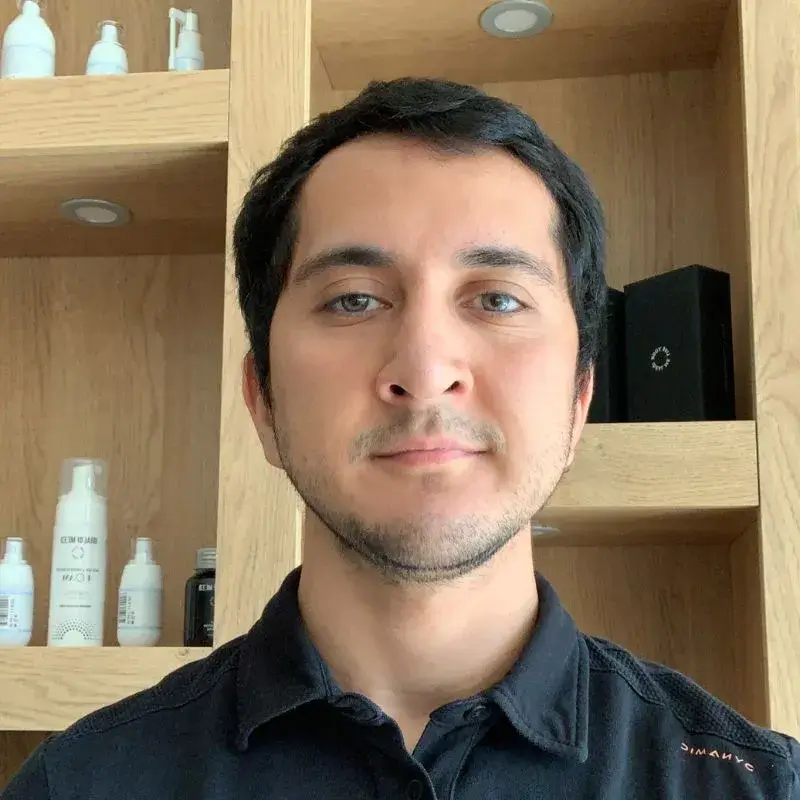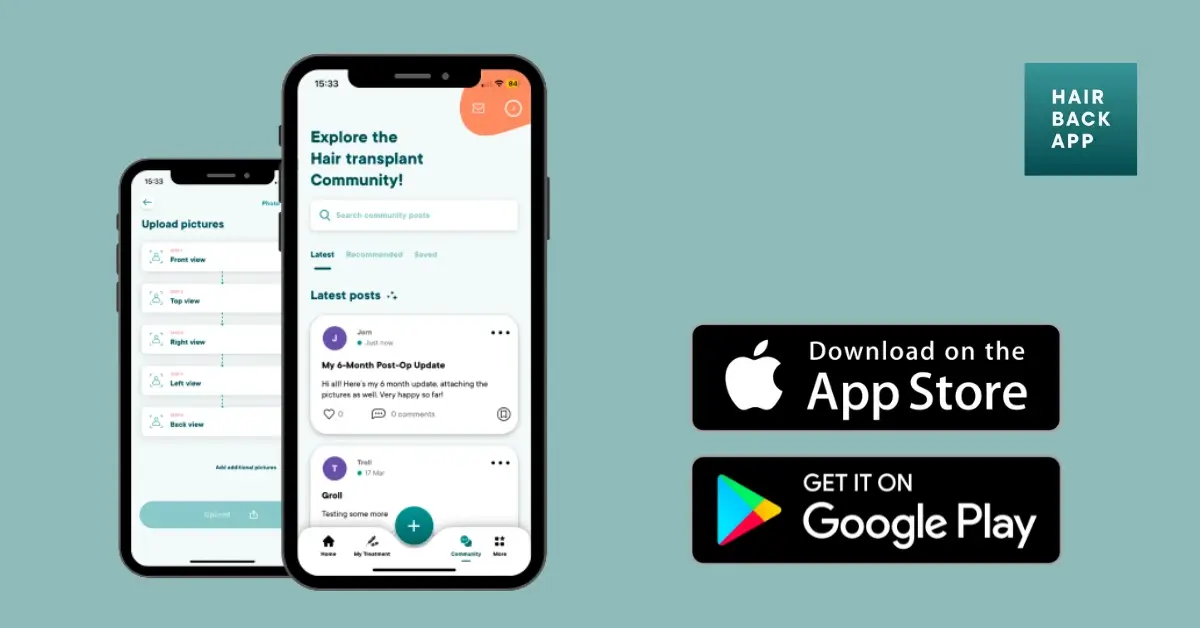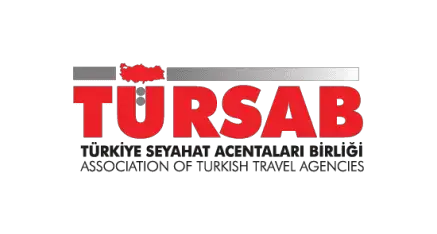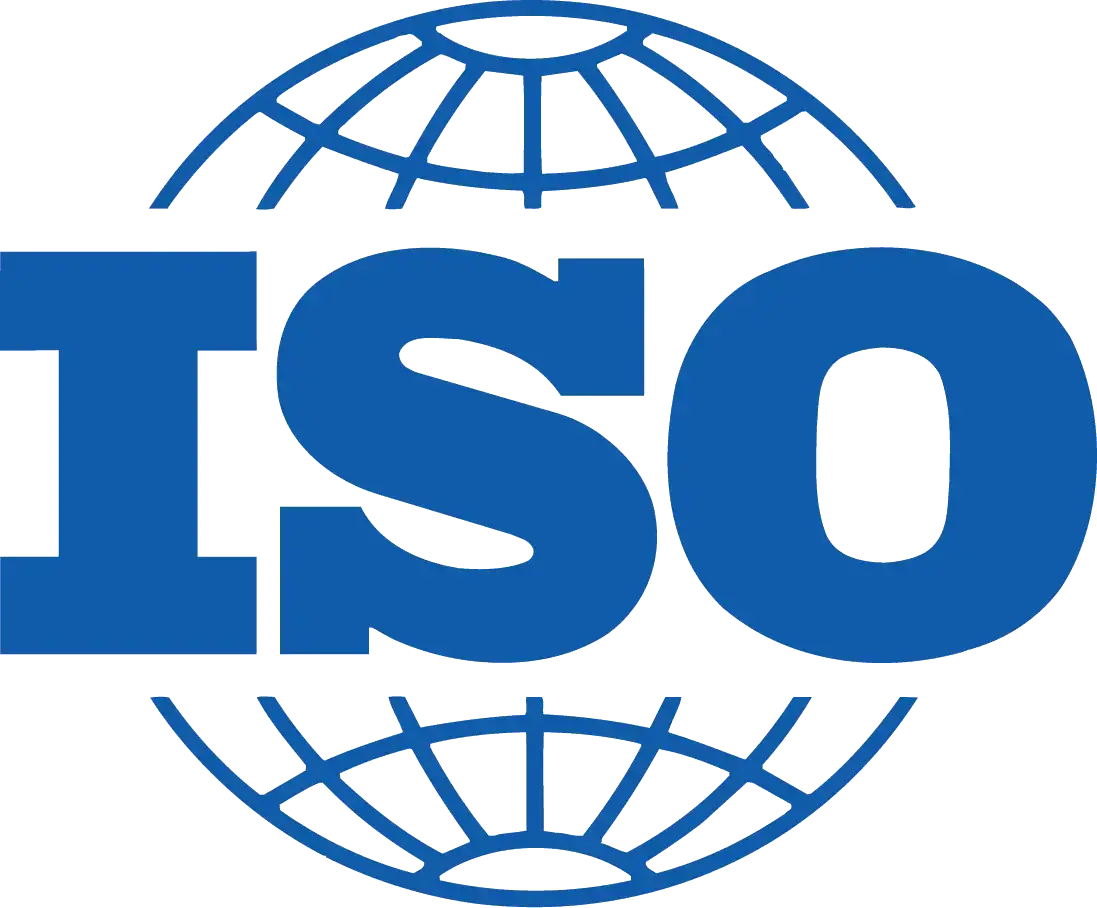Hair Transplant Aftercare
Reference guide for (prospective) patients at IdealofMeD

Last edited, 8 April 2024
Thanks for reading the IdealofMeD hair transplant aftercare guide. This should have all the general information to give you an idea of how we continue to help you after your hair transplant. Keep in mind that the information in this guide is generic and might not apply to your situation – always follow the direct instructions from me or the people in my team.
Table of Contents
Downloading the Hair Back App

We closely cooperate with the Hair Back App for our aftercare support. This way we can assign you an personalized treatment plan that you can follow. You will mostly use the app when you’re back at home – so more information about that further down the page!
To download the Hair Back App, download it on the App Store or get it on Google Play.
You can start using the Hair Back App before your hair transplant already as well to talk to others in the community. Here’s a video from Frank explaining how the Hair Back app works.
Directly after the hair transplant
Again – this information is generic! It might be that we have discussed another treatment protocol for you and have uploaded that in the app. Always follow your personalized instructions if they are different from what is described here. If you have questions, just contact us!
Congratulations with your hair transplant! This is an extremely exciting milestone. While you will most probably have some discomfort in the coming days, your hair will look better each day from today. I can’t wait to celebrate your 12-month milestone and see you fully transformed. Me and my team are here for you for the full 365 days until we get there. If you have any questions or concerns, we’re only a WhatsApp message, email or call away.
While I know you’re excited too – it is incredibly important to continue to follow the ‘rules’ that we set out. Hair transplants are delicate and following the rules are essential to producing the optimal result. You’ll read all about them further down the page.
What you need to know about the first 24-48 hours after that hair transplant.
- All medication and required products are given to you directly after the hair transplant as part of your hair transplant package free of charge.
- You’ll have to use the provided neck pillow for sleeping instead of a normal pillow
- You can’t have any contact with the transplanted area, which includes touching with your fingers, sunglasses or hat
- Take the required medication as prescribed, this includes a gastroprotective, pain killer, blood thinner, antibiotics and anti-oedema agents
- The 1st or 2nd day after your hair transplant you will return to the hospital for the first wash where we show you exactly how to wash your hair. Having someone record this on your phone is advised for future reference.
- Both before and for at least 10 days after the hair transplant, you’re not allowed to smoke.
When you're back at home
For the first 10 days
- Use the special neck pillow for sleeping
- No contact with the implanted area
- Wash your hair daily as shown in the hospital
- Upload pictures every other day in the app. If there is anything that resembles folliculitis or infection, I will consult the medical team.
- No smoking
- You remove the scabs on 10th day post operation (start counting the day after the operation)

After that
The app will prompt you to upload pictures on a monthly basis that will be reviewed by me or my team. If anything is off, we’ll discuss this with the medical team. We’re available for 12 months after your hair transplant for any questions. After which we’ll officially celebrate your completed hair transplant! Of course, you can contact us after the 12 months are over as well!
Immediate questions or concerns
If you have any immediate questions, write me or your contact on WhatsApp. You can send an email to me directly as well, fatih.ozsoy@idealofmed.com. We are available during office hours from Monday to Friday, but often answer outside of office hours as well. If your question can’t wait, contact our support team 24/7 to talk to someone within 5 minutes. If necessary, they can reach our on-call medical support.
24/7 Support Team
- we are online
Detailed Aftercare Protocol and Instructions
How to Take the Medicines
Gastroprotective (Lansor 30 mg) – gastroprotective tablet must be taken 1 pill, daily 30 minutes before breakfast for 28 days.
Anti-inflammatory and Painkiller (Etol Fort 400 mg) – anti-inflammatory and painkiller tablets must be taken on a full stomach twice a day for 5 days starting the following day of the operation.
- 1 pill in the morning after breakfast,
- 1 pill in the evening after dinner,
- In the existence of pain after 5 days 1 pill a day must be taken on a full stomach.
Antibiotic (Augmentin-BID 100 mg) or Cipro – antibiotic tablets must be taken on a full stomach twice a day for 5 days starting the following day of the operation;
- 1 pill in the morning after breakfast,
- 1 pill in the evening after dinner,
Anti-oedema (Prednol 16 mg) – anti-oedema tablets must be taken on a full stomach as follows, starting next day after the operation;
- 1st Day: 3 pills at once after breakfast,
- 2nd Day: 2 pills at once after breakfast,
- 3rd Day: 1 pill after breakfast,
- in the existence of oedema after 3 days 1 pill must be taken on a full stomach for 2 days.
- refraining from salt consumption while using corticosteroid anti-oedema medicine is important.
Coraspin 100 mg – Coraspin tablets must be taken on a full stomach once a day for 28 days, starting the next day of the operation;
- Coraspin thins the blood, therefore is used to enhance the healing of implanted area and increase the quality of new hairs.
No alcohol should be used while using Coraspin.
Use only these medicines and post-operative care products as suggested here.
How to Sleep After Hair Transplant
Lie on your back and use multiple pillows to keep your head high. Use the provided neck pillow around your neck. You should sleep in this position for 10 days from the night of the day of the operation.
The idea is to sleep with your head and upper body propped up on several pillows for the first 10 days. This will prevent swelling of the forehead. Alternatively, sleeping in a lazy-boy recliner with your head and upper body elevated is also effective.
How to Wash Your Head
The donor area will be covered with a bandage after the operation. You will need to remove that bandage 24 hours after the surgery.
The washing starts on the first day after the operation. It must be done once a day every day for 10 days. Only the lotion and the foam supplied by Hair Expert should be used for these washings during this time. No other products must be applied onto the head. You will be shown how to wash your head during your first wash.
- Step 1: Shake the Idealofmed Foam (with black font) container and apply the lotion onto the implanted and donor area. Do not rub or scratch as the grafts are sensitive. Instead, dab on the transplantation area without moving the grafts out (up and down movements). Massage on the back with circular motions on the donor area and wait for 15-20 minutes.
- Step 2: Rinse the head with unpressurised lukewarm water, with a jar or a pitcher for instance. Avoid using a showerhead on your head for at least 10 days after the operation.
- Step 3: Make the Idealofmed shampoo (with black font) foamy in your hands. Apply it on the transplantation area and the donor area. Just like with the foam, dab on the transplantation area gently and do not move the grafts. Apply the massaging movement on the donor area one more time.
- Step 4: Rinse as instructed in Step 2.
- Step 5: Dry the implemented and donor area by using a paper towel applying gentle up/down movements. Prevent cotton towels and electronic dryers for the first 10 days.
- Step 6: Apply the Bepanthen cream on the donor area by massaging the area. Do not wash it off afterwards. Carry out this procedure every day for 10 days.
The Wash on Your 10th Day
The scabs and the dead skin will have mostly fallen off by the 10th day. If not, you must apply Bepanthen cream on your transplanted area, wait 30 minutes and then gently massage the area with your fingertips (do not have your nails contact the area) and remove all the scabs during the 10th wash. Following the last wash, photos of your scalp from different angles should be sent to our office for further evaluation of your operation.
Protecting Your Head
You will need to pay utmost care not to hit your head and cause damage for implanted grafts! The protection of the implanted area is paramount therefore the provided hat shall not be worn for the first 10 days after the operation. If for some reason there is this necessity, high attention is recommended while wearing the hat.
Important Rules
You should refrain from exercise such as running, cycling, and weightlifting, as well as activities such as golf, baseball, swimming, Scuba Diving, etc. for at least 30 days after your surgical procedure. Such activity, when enjoyed before this critical period, may result in sweating, bleeding, and loss of grafts.
Do not bend over or engage in any lifting for at least 72 hours after surgery to avoid bleeding or excess swelling. Keep your head and upper body elevated above the level of your heart during this time, especially while sleeping.
The swelling is PAINLESS, it will begin on the forehead and over the bridge of the nose. It may proceed to surround the eyes. IF THIS OCCURS, DO NOT PANIC. The swelling will subside spontaneously in 2 to 3 days. Anti-oedema medicine will remove the swelling in time.
The graft sites will form scabs in 24 to 72 hours after surgery, and the scabs fall off in 3-10 days.
As the scabs fall off, you may notice that hair is shed with them. THIS IS NORMAL. The shedding of the hair typically starts within the first or second week of the operation, and it continues until the end of the third month.
Do not pick or scratch the scabs, doing so can cause infection and endanger the survival of the grafts.
Prevent direct sunlight exposure on the scalp until the redness fades out completely.
You cannot shave your hair after the operation. You must wait 1 month until you can cut your hair by scissors only. You can use trimmers 3 months after the operation on the donor area, and 6 months after the operation on the implantation areas.
You cannot use a hair dryer for the first 10 days after the operation.
How to Use IdealofMeD Products
IdealofMeD Hair Restoring Shampoo – use the shampoo after your 20th-day post-operation, start applying the shampoo 1 time per wash until you run out of the bottle.
IdealofMed Hair Vitamins – tablets must be taken on a full stomach once a day for 6 months starting 20 days after the operation.
Please note that it is strongly suggested to use these post-operational products in order to support the healing process and to achieve the best possible results from your procedure. We provide you with these products for 2 months of use and free of charge. You may ask your patient consultant to provide you with additional products.
Post-Operational Checklist
The most sensitive day for transplants is the first day following the hair restoration procedure. For the first several days, the hair follicles are adapting to their placement and must be cleaned carefully.
It is important that scabbing be cleared away during shampooing, so as not to inhibit the new hair growth.
Following a hair restoration surgery, it is possible to experience some general complications such as swelling, redness, or discomfort around the transplanted area. These are normal reactions and usually subside quickly.
How Transplanted Hair Grows
Scalp hair does not all grow at the same time. At any given moment hairs may be growing, resting, or shedding. This cycle is on their schedule -transplanted hair cycle in this same random fashion.
The process of removing, dissecting, and transplanting donor hair generally “shocks” the follicles into the resting phase. For this reason, most patients will shed all or most of the hairs in the grafts at about 6-8 weeks post-op.
Beginning 2-3 months post-op, the transplanted hairs begin to “germinate” below the skin.
In-grown hairs may happen on occasion. They present as a red, raised pimple-like bumps in the grafted area. In-grown hairs will resolve on their own time.
You will be able to see the transplanted hairs start to regrow between months 4-6 visibly. At month 6, a patient may expect to see growth from 40-60% of the transplants. Again, due to the random cycle of hair growth, not all grafts will start growing at the same time. Initially, the hair may be thinner and finer. It will gain length and density as it matures.
Please take in consideration that the implanted hair on the crown area takes significantly longer time to fully grow compared to the frontal areas.
Full growth from the transplants is usually achieved at 12 months. In some cases, this can take up to 18 months. This is especially common in female patients. The transplanted hairs will continue to gain length over time.
Post-Transplant Expectations & Concerns
Waiting for hair regrowth can be an anxious experience. Following the transplantation of hair follicles, hair regrowth occurs in about two to three months. However, new hair may not be visible above the scalp for several more months. Further delaying the visibility of results is the fact that only a portion of the transplants demonstrate regrowth initially.
While waiting for hair regrowth, remember that initial results may not indicate the success of the surgery. Continuous improvement should be seen for up to a year and a half following the procedure.
Hair regrowth will occur at different rates, from individual to individual. It is also normal for some patients to see what appears to be an imbalance in the areas of regrowth. For example, hair may appear fuller on one side of the head than the other. As regrowth continues, the distribution of the hair will soon appear more even.
During the early stages of the transplantation process, it is also important to keep in mind that the transplanted follicles will shed their hair before true hair regrowth occurs. Though this may seem to indicate that transplantation was unsuccessful, this shedding is a normal part of the process.
We are confident that with patience, you will be extremely satisfied with your new, fuller head of hair.
Over 50 Before & After images
- we are online
Schedule For Later
About IdealofMeD
Sources & expertise
Information checked by an expert
Fatih Özsoy
During the aftercare of your hair transplant me and my team will be your main points of contact. Whatever the question or concern, if you share them with us we’ll help you get the right answer.
Awards & accreditations



IdealofMeD Hair Transplant
We’re you’re number 1 destination for a hair transplant in Turkey.


